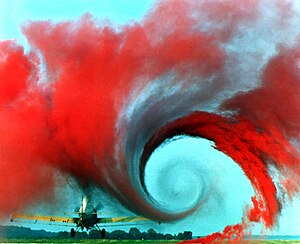 Image via Wikipedia
Image via Wikipedia
Wake turbulence is one of the most common flight disturbances. Most pilots experience it on a regular basis. In short, wake turbulence is the result of wake vortices that are created whenever an airfoil produces lift. Lift results from a pressure differential at the wing surfaces, with the lowest pressure occurring above the wings and the highest pressure occurring beneath them. The pressure differential then causes a rollup of the airflow behind the wings, which results in a swirling air mass that occurs downstream of the wingtips. The air mass rotates counterclockwise at the right wing and clockwise at the left wing.
Slow flying, heavy aircraft produce the strongest wake, but short wing aircraft, due to their short wings, are the most prone to experiencing a variety of wake turbulence situations, the most dangerous of which is an induced roll and yaw. Because the pilot has little altitude for recovery, induced roll and yaw is particularly dangerous during take off and landing. During takeoff and landing, vortices push toward the ground and move away from the runway when the wind is low. But moderate to high wind keeps upwind the vortex in vicinity of the runway, which can cause the down wind vortex to push an aircraft into neighboring runway paths. When an aircraft reaches altitude, vortices stabilize at between 500 and 900 feet beneath its flight level. Until then, however, pilots must make certain to avoid drifting into other flight paths.
Uncommanded aircraft movements are the greatest indicators that an airplane is experiencing wake turbulence. Because the onset of wake turbulence is often surprisingly subtle, there have been many fatal instances where pilots attempted a landing during mild turbulence only to experience severe turbulence as they neared the runway. When a pilot suspects that wake is affecting his or her aircraft upon landing, the safest move is to execute a go-around or a missed approach in order to prepare for stronger wake turbulence on the re-approach.
With that said, there are ways to insure that wake turbulence is avoided in the first place. Starting with takeoff, departing a few minutes later than your scheduled departure time if another aircraft immediately preceded you is a smart idea, especially on a windy day. Then, once you depart, avoid crossing behind and below the preceding plane. Instead, try to climb above the plane's flight path or deviate slightly upwind from its path. If you have no choice but to cross behind and below its path, attempt the pass at 1000 feet or more below its flight path. When landing, make sure that your touchdown point is well ahead of a preceding aircraft's touchdown point, and always land well before an outgoing aircraft reaches its rotation point. If you're landing behind another aircraft on a crossing approach, be sure to cross above its flight path.
Avoiding wind turbulence is one the most important safety aspects for large and small aircraft alike. Unless you take the right precautions, wind turbulence can lead to an induced roll and yaw, which can be fatal upon takeoff or landing. Wind turbulence is an everyday aspect of flying. But unless pilots understand how it works and, therefore, how to avoid letting it get the best of their aircraft, their chances of experiencing an induced roll and yaw remain high. For more information on wind turbulence and how to avoid it, visit apstraining.com. They are expert instructors in aerobatics and spin/stall flight training.
Article Source: http://EzineArticles.com/?expert=Jimmy_Drago
http://EzineArticles.com/?Understanding-Wake-Turbulence-and-How-to-Avoid-It&id=3049223

No comments:
Post a Comment